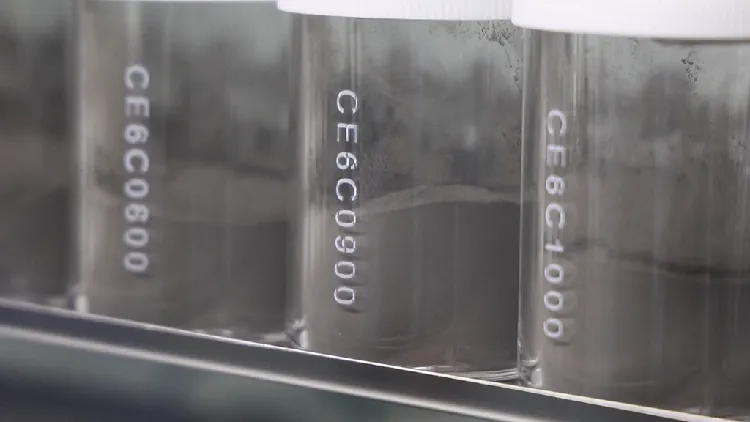
Revolutionary Discoveries: China's Chang'e-6 Samples Illuminate the Moon's Hidden Secrets
2025-07-10
Author: Arjun
Unlocking the Moon's Mysteries
A groundbreaking series of studies by Chinese researchers has revealed astonishing insights from the Chang'e-6 mission's samples collected from the moon's enigmatic far side. These findings shed light on volcanic activity, ancient magnetic fields, water content, and geochemical characteristics, providing unprecedented clarity on the moon's concealed evolutionary history.
The Far Side: A World Apart
While the moon always presents a familiar face to Earth, its far side remains largely uncharted territory, cloaked in mystery. Recent research published in the journal *Nature* unveils profound differences between the moon's near and far sides, including variations in morphology, composition, and magmatic activities—a tantalizing puzzle that scientists have long sought to solve.
Historic Sample Collection
A landmark achievement for the Chang'e-6 mission came in 2024 when it successfully returned 1,935.3 grams of lunar samples from the South Pole-Aitken (SPA) Basin. This basin, the largest and oldest on the moon, serves as a treasure trove for understanding the differences between the moon's sides and offers clues to the impact that shaped its history.
Understanding Cataclysmic Events
The SPA Basin, spanning approximately 2,500 kilometers, was formed by an impact that released energy equivalent to a trillion atomic bombs. Yet, its influence on lunar evolution had long remained a mystery. The revelations from these new studies uncover the dramatic consequences of this colossal impact, marking a major scientific breakthrough.
A Volcanic Past Revealed
Through meticulous analysis, scientists have identified evidence of volcanic activity on the moon's far side dating back 4.2 billion to 2.8 billion years, suggesting that this geological dynamism persisted for over a billion years. This insight significantly alters previous assumptions about the moon's volcanic history.
Ancient Magnetic Secrets
Moreover, the Chang'e-6 samples have unveiled ancient magnetic field data, indicating a resurgence in the moon's magnetic intensity around 2.8 billion years ago. This fluctuation points to potential variations in the moon's internal dynamics, further complicating our understanding of its evolution.
Water Woes: A Tale of Two Hemispheres
The findings also reveal a stark disparity in water distribution: the far side's mantle is significantly more arid than that of the near side. This crucial difference raises important questions about the moon's geological processes and the implications for its history.
A New Perspective on Lunar Development
These discoveries represent humanity's first direct access to vital evidence about the deep material properties on the moon's far side. According to Li Chunlai from the National Astronomical Observatories, this information is pivotal for understanding the layered evolution of the moon's interior.
The Dawn of New Research
In addition to exciting revelations, scientists have scrutinized the physical and mineralogical traits of the Chang'e-6 samples. They pinpointed the formation of the SPA Basin at approximately 4.25 billion years ago, providing a critical timeline for studying early solar system impacts.
Global Impact on Lunar Science
Experts believe these revelations could overturn established theories in lunar science. Professor Mahesh Anand noted that while prior missions supplied samples for over 50 years, new data from Chang'e-6 is reshaping our understanding and prompting necessary reevaluations.
The Future of Lunar Exploration
As the scientific community continues to unravel the mysteries of the moon, the Chinese Academy of Sciences is placing significant emphasis on ongoing research efforts. With hopes for advancing space science and technology, officials encourage more collaboration to leverage the findings from these extraterrestrial samples.
Previously, the Chang'e-5 mission revealed young volcanic activity on the moon's near side, extending the timeline of lunar volcanism by a billion years. Such successes exemplify the fruitful union of science and engineering—an ethos that drives China's ambitious lunar exploration program.




 Brasil (PT)
Brasil (PT)
 Canada (EN)
Canada (EN)
 Chile (ES)
Chile (ES)
 Česko (CS)
Česko (CS)
 대한민국 (KO)
대한민국 (KO)
 España (ES)
España (ES)
 France (FR)
France (FR)
 Hong Kong (EN)
Hong Kong (EN)
 Italia (IT)
Italia (IT)
 日本 (JA)
日本 (JA)
 Magyarország (HU)
Magyarország (HU)
 Norge (NO)
Norge (NO)
 Polska (PL)
Polska (PL)
 Schweiz (DE)
Schweiz (DE)
 Singapore (EN)
Singapore (EN)
 Sverige (SV)
Sverige (SV)
 Suomi (FI)
Suomi (FI)
 Türkiye (TR)
Türkiye (TR)
 الإمارات العربية المتحدة (AR)
الإمارات العربية المتحدة (AR)